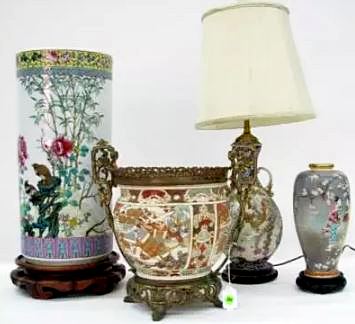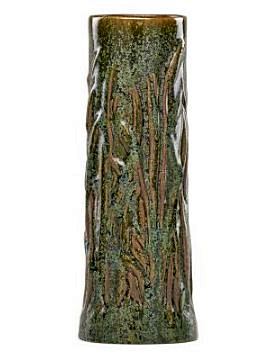HOW TO IDENTIFY CERAMICS
Types and meaning of Porcelain & Pottery marks
.jpg)
If you have a passion for collecting ceramics, you know that each piece has its unique signature. Most ceramics bear a maker's mark or backstamp, which usually denotes the studio or manufacturer and, at times, includes the artist's initials or signature. These marks are usually located on the underside, whether it is a figurine or pottery vase.
However, if you are new to the world of ceramics, these marks can be puzzling. Understanding these labels is essential, particularly if you're interested in collecting or selling these items. In this article, we will provide you with a guide to ceramics marks and how to interpret them.
The Importance of Ceramics Marks
Ceramics marks tell the story of the piece, including its maker, country of origin, and date of production. Knowing this information can help you determine the value and rarity of the piece. Moreover, these marks serve as a guarantee of authenticity, particularly in the case of antique ceramics.
Most Studio or Art Pottery is unique and rarely reproduced in large quantities unless they were made for utilitarian purposes, such as pottery jugs or ceramic cookware and tableware that are usually branded in the same pattern and perhaps modeled by a particular designer. Arts & Crafts pottery is often made in smaller numbers.
Types of Ceramics Marks
The vast majority of ceramics makers' marks can be classified by the manner they were applied. For example, the most common way to mark porcelain is to use an ink stamp, also referred to as a backstamp. Impressed or incised marks and symbols are common, too. Some, such as hand-decorated figurines, are signed with handwritten initials or a simple logo of the artist or modeler. Additionally, most marks and backstamps are underglaze, and some are overglaze.
Overglaze porcelain marks tend to be those of retailers, distributors or exporters that had items made to order by one or more porcelain factories or potteries. In very few instances, some overglaze marks are large irregularly shaped smudges or at times resemble a certain shape, for example, a flower, and are usually in gold or black ink. These marks are called “overmarks” and are usually placed immediately prior to a sale by a trading company. Their purpose is to conceal the original manufacturer’s mark by the final seller, usually for reasons of marketability if the actual maker is of inferior reputation, but the item is in a famous style. Overmarks were very popular around 1880s – 1930s, mostly on European porcelain that was made by smaller or relatively unknown companies and destined for import to the US.
Country of Origin Notation
The country of origin notation was required to be displayed next to or near the maker's mark on all imports to the US since 1891 by Act of Congress (Tariff Act). This means that in general, porcelain and chinaware that include the country of origin next to or near or within their maker's mark were made after 1891. However, many recent imports to the US and Europe, particularly those from Asia, usually place a sticker or label to satisfy this legal requirement and which is often removed or lost.

Japanese Porcelain Marks
Initially, Japanese makers and trading companies marked their wares with the name "Nippon," which is the official name for Japan. However, in 1921, the US Congress requested that Japanese Customs Authorities change the name to "Japan." As a result, porcelain and chinaware marked "Nippon" were made before 1921, and those marked "Japan" were made after.
Interestingly, most imported Japanese porcelain from this time period rarely carried the manufacturer's mark. Instead, they displayed the logo of the Exporter or Trading Company responsible for their distribution. For example, Noritake, one of the most well-known companies, used nearly 400 independent porcelain factories to create their products, making it challenging to identify the maker of each piece. The same is true of other major Japanese porcelain companies, each using unique symbols to distinguish their products during different periods.
So when you see a mark that reads "Japan" or "Nippon," keep in mind that these items were likely made by one of several hundred porcelain factories and imported to the US and Europe by a trading company whose logo or backstamp is shown on each piece. Look for ink-stamped marks or labels (stickers) to identify these intricate and beautiful pieces of history.
European Porcelain and Pottery Marks
When it comes to porcelain and chinaware, importers and trading companies often applied their own marks or logos and not necessarily those of the manufacturer, regardless whether they were based in America or Europe. This practice was common throughout the late 19th century and well into the early-to-mid 20th century. For instance, many porcelain items imported from Europe show the trading company's logo, either alone or near the actual maker's mark. This is especially true for items from Germany, France (mostly Limoges), Austria, Czechoslovakia, and other countries. Most specimens of this type have a country of origin stamp, such as GERMANY, FRANCE, AUSTRIA, etc., and they generally date from the 1890s to the 1930s.
On the other hand, practically all British porcelain, earthenware, or Bone China have the actual maker's mark printed or impressed and often include a symbol indicating the design's official registration, such as an Rd Number or Registration Diamond cipher. The marks' shape and color may also vary, making them unique to each manufacturer. Whether you're a collector or an enthusiast, recognizing these distinct markings can be both exciting and rewarding.

Art and Studio Pottery Marks
When it comes to pottery or clayware, particularly Art and Studio Pottery, identifying the country of origin can be challenging as most pieces are made in small quantities or even just once, making them relatively unique. As a result, the country of origin is rarely shown or required. For very old or very recent pottery pieces, especially those made by occasional potters or unknown craftsmen, identification can be even more difficult. However, most pottery studios and artisans that worked during the 20th century are well-documented, and their signatures, initials, and logos can be found on our research website in the Ceramics section. Some independent artists used a particular studio's facilities and marked their wares accordingly, while others were actually employed by the company. Furthermore, modelers and decorators who worked for major studios or factories, such as Weller, Roseville, and other Ohio Valley or California Potteries in the US, are also included in our Ceramics section of our marks4antiques.com research website.
Conclusion
In recent years, there has been a growing interest in collecting and identifying vintage and antique ceramics, and knowing how to decipher the various maker's marks and backstamps is essential for any serious collector. In addition to providing information about the manufacturer or studio, these marks can also reveal important details about the age, rarity, and value of a particular piece. For example, some marks may indicate that a piece was made during a certain period or under the direction of a specific artist, while others may suggest that it was produced in limited quantities or is a rare find.
However, it's important to note that while maker's marks and backstamps can be helpful in identifying and dating ceramics, they are not foolproof. For one thing, not all pieces were marked, especially those made before the 19th century. Additionally, some makers or studios may have used multiple marks or changed their marks over time, making it difficult to trace the origin of a particular piece. Moreover, some unscrupulous sellers may try to pass off modern reproductions or forgeries as genuine antiques by adding fake or misleading marks.
To avoid these pitfalls, collectors should do their research and consult reputable sources to learn more about the history and characteristics of the ceramics they are interested in. They should also be wary of overly polished or perfect pieces, which may be signs of modern reproductions, and always examine the marks and backstamps closely to look for inconsistencies or irregularities.
Finally, maker's marks and backstamps are a fascinating and important aspect of ceramics history and collecting. By understanding the different types of marks and their meanings, collectors can gain valuable insights into the origins and values of their favorite pieces, and better appreciate the artistry and craftsmanship of these beautiful and timeless objects.
Unlock the true value
of your collection with our comprehensive research guides from identifying makers' marks to appraising all kinds of
antiques and collectibles.
Our up-to-date information will give you an accurate understanding of your items' worth. Don't miss out on this
valuable resource - visit our research tools today!
Search our price guide for your
own treasures





